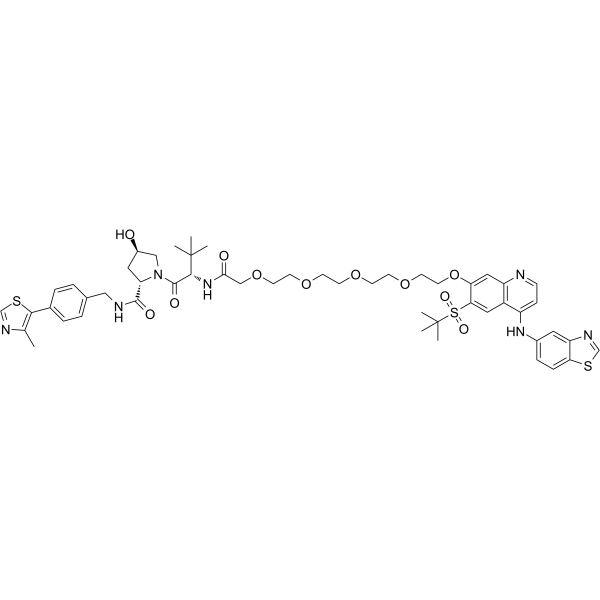Physicochemical Properties
| Molecular Formula | C52H65N7O11S3 |
| Molecular Weight | 1060.30780959129 |
| Exact Mass | 1059.39 |
| CAS # | 1801547-16-9 |
| PubChem CID | 91799297 |
| Appearance | Light yellow to yellow solid powder |
| LogP | 5.9 |
| Hydrogen Bond Donor Count | 4 |
| Hydrogen Bond Acceptor Count | 17 |
| Rotatable Bond Count | 26 |
| Heavy Atom Count | 73 |
| Complexity | 1870 |
| Defined Atom Stereocenter Count | 3 |
| SMILES | S(C1=CC2=C(C=CN=C2C=C1OCCOCCOCCOCCOCC(N[C@H](C(N1C[C@@H](C[C@H]1C(NCC1C=CC(C2=C(C)N=CS2)=CC=1)=O)O)=O)C(C)(C)C)=O)NC1C=CC2=C(C=1)N=CS2)(C(C)(C)C)(=O)=O |
| InChi Key | RIEGJNXDHULIKM-GPPJZCFZSA-N |
| InChi Code | InChI=1S/C52H65N7O11S3/c1-33-47(72-31-55-33)35-10-8-34(9-11-35)28-54-49(62)42-25-37(60)29-59(42)50(63)48(51(2,3)4)58-46(61)30-69-21-20-67-17-16-66-18-19-68-22-23-70-43-27-40-38(26-45(43)73(64,65)52(5,6)7)39(14-15-53-40)57-36-12-13-44-41(24-36)56-32-71-44/h8-15,24,26-27,31-32,37,42,48,60H,16-23,25,28-30H2,1-7H3,(H,53,57)(H,54,62)(H,58,61)/t37-,42+,48-/m1/s1 |
| Chemical Name | (2S,4R)-1-[(2S)-2-[[2-[2-[2-[2-[2-[4-(1,3-benzothiazol-5-ylamino)-6-tert-butylsulfonylquinolin-7-yl]oxyethoxy]ethoxy]ethoxy]ethoxy]acetyl]amino]-3,3-dimethylbutanoyl]-4-hydroxy-N-[[4-(4-methyl-1,3-thiazol-5-yl)phenyl]methyl]pyrrolidine-2-carboxamide |
| HS Tariff Code | 2934.99.9001 |
| Storage |
Powder-20°C 3 years 4°C 2 years In solvent -80°C 6 months -20°C 1 month |
| Shipping Condition | Room temperature (This product is stable at ambient temperature for a few days during ordinary shipping and time spent in Customs) |
Biological Activity
| Targets | VHL |
| References |
[1]. Catalytic in vivo protein knockdown by small-molecule PROTACs. Nat Chem Biol. 2015 Aug;11(8):611-7. [2]. VHL-based PROTACs as potential therapeutic agents: Recent progress and perspectives. Eur J Med Chem. 2022 Jan 5;227:113906. |
Solubility Data
| Solubility (In Vitro) | DMSO : 150 mg/mL (141.47 mM) |
| Solubility (In Vivo) |
Solubility in Formulation 1: ≥ 7.5 mg/mL (7.07 mM) (saturation unknown) in 10% DMSO + 40% PEG300 + 5% Tween80 + 45% Saline (add these co-solvents sequentially from left to right, and one by one), clear solution. For example, if 1 mL of working solution is to be prepared, you can add 100 μL of 75.0 mg/mL clear DMSO stock solution to 400 μL PEG300 and mix evenly; then add 50 μL Tween-80 to the above solution and mix evenly; then add 450 μL normal saline to adjust the volume to 1 mL. Preparation of saline: Dissolve 0.9 g of sodium chloride in 100 mL ddH₂ O to obtain a clear solution. Solubility in Formulation 2: 7.5 mg/mL (7.07 mM) in 10% DMSO + 90% (20% SBE-β-CD in Saline) (add these co-solvents sequentially from left to right, and one by one), suspension solution; with ultrasonication. For example, if 1 mL of working solution is to be prepared, you can add 100 μL of 75.0 mg/mL clear DMSO stock solution to 900 μL of 20% SBE-β-CD physiological saline solution and mix evenly. Preparation of 20% SBE-β-CD in Saline (4°C,1 week): Dissolve 2 g SBE-β-CD in 10 mL saline to obtain a clear solution. (Please use freshly prepared in vivo formulations for optimal results.) |
| Preparing Stock Solutions | 1 mg | 5 mg | 10 mg | |
| 1 mM | 0.9431 mL | 4.7156 mL | 9.4312 mL | |
| 5 mM | 0.1886 mL | 0.9431 mL | 1.8862 mL | |
| 10 mM | 0.0943 mL | 0.4716 mL | 0.9431 mL |
